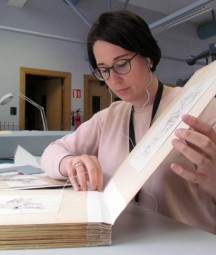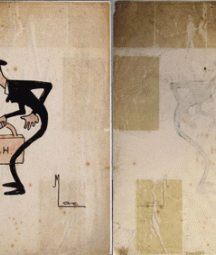Dr. Neassa Doherty (Volunteer NLI Prints & Drawings Dept., 2012 & PhD Graduate, NUIG, 2015) & Louise O’Connor (NLI Conservation Dept.)
In 1742, the Dublin engraver and printseller, John Brooks, advertised that a mezzotint print of Hugh Boulter would be printed on “superfine Royal Irish Paper” (see fig. 1). Brooks’ claim to use Irish paper for this mezzotint was unusual. What prompted his direct reference to an Irish paper source? Can Brooks’ notice be read literally, or was it part of a clever advertising strategy? Intrigued by Brooks’ advertisement, a close examination of one rare example of the Boulter mezzotint print, housed in the NLI Irish Portraits Collection, gives a fascinating insight into the 18th century Dublin mezzotint trade.
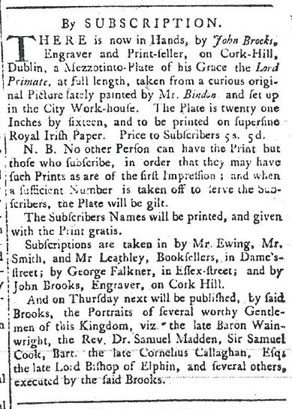
Fig. 1. Brooks advertises a mezzotint print of Hugh Boulter in 1742. (The Dublin Mercury, 23 Jan-21/25 Sept 1742)
Mezzotint Technique & the Dublin Group
Mezzotint is a tonal intaglio printmaking process, developed in the 18th century, and mainly used for the reproduction of oil paintings. As a novel and affordable luxury good, the fashionable gentry often framed and decorated their homes with print portraits.
John Brooks (c. 1710-1756) was the leading member of the Dublin Group, a small network of highly skilled mezzotint engravers trained and employed at his workshop (Cork Hill, Dublin c. 1740-1746). These Irish craftsmen are frequently credited for introducing mezzotint portraiture into the Irish market during the 1740s. Brooks’ most successful student, James McArdell (c. 1728-1765), reproduced many high-quality mezzotints in London.
Brooks’ mezzotint print of Hugh Boulter is after an oil painting by Irish artist Francis Bindon (c. 1690-1765), which is housed in Trinity College Dublin. Hugh Boulter (1672-1742) was Primate of Ireland until his death in 1742, just months before this mezzotint was made. Boulter was an important political figure and Brooks would have anticipated much commercial demand for this print. Mezzotint requires a type of paper that absorbs as much ink as possible to capture the sitter’s likeness. The reference to the use of Irish paper for a mezzotint was therefore intriguing.
The NLI print is an off-white laid sheet and measures 531 x 397 mm (see fig. 2). The print matches Brooks’ advertised plate of 21 x 16 inches (or 530 x 400 mm). By identifying a watermark in the NLI print, could we reveal for the first time if Brooks did indeed use Irish paper?
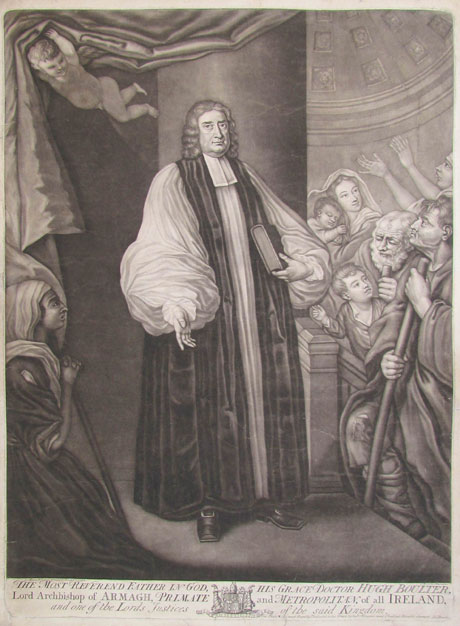
Fig. 2. Hugh Boulter in mezzotint by John Brooks after Francis Bindon c. 1742 (NLI Call no. PD BOUL-HU (4) III)
What is a Watermark?
A paper sheet is formed when a cotton and linen pulp solution is drained through a sieve distributing a layer of pulp fibres behind. Up until the mid-18th century, paper was mostly made on a ‘laid’ metal-wire sieve, called a mould. On commissioning his moulds from the mould-maker, the papermaker may include a watermark or countermark design twisted into the metal wires. This watermark identifies the papermaker, and so it was used as a hallmark of quality. The papermaker may also include his initials or his countermark in the sheet. Hundreds of watermarks are recorded. Watermark identification is usually of great importance for dating paper and determining the location of the paper mill.
Investigation
A paper sheet will transmit light (i.e. light shines though it) so using a light source, the fibre distribution of a paper sheet can be examined. The visual identification of watermarks in mezzotint prints can be challenging, as the sheet is usually covered in a dense layer of black ink. Examination of Brooks’ mezzotint print using transmitted light showed a shield with three diagonal lines (a bend) surmounted by a lily (see figs. 3 and 4). This watermark is known as a Strasburg bend and lily. Another Dublin Group mezzotint within the NLI’s collection, James McArdell’s portrait of John Armstrong (c. 1748) also has a Strasburg bend and lily watermark.
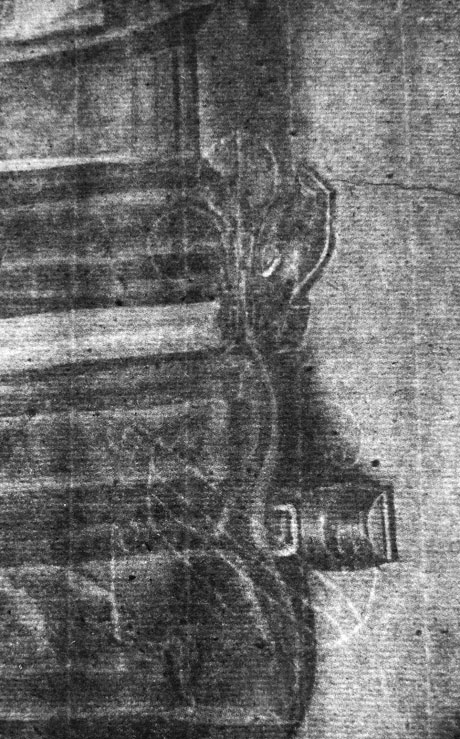
Fig.3 Detail of the Boulter print in transmitted light, showing a Strasburg bend and lily watermark.
Watermarks were often characteristic of a certain size sheet. The Strasburg bend and lily watermark is often linked with royal paper sheets (the term royal refers to a standard size of paper measuring 25 x 20 inches). In the 1740s, the watermark is associated with Dutch papermaking firms, including Gerrevink and Villedary, Honig and Honig & Zoonen. A countermark, which sometimes gives the papermaker’s name or initials and also the year of production, is not visible in these prints.
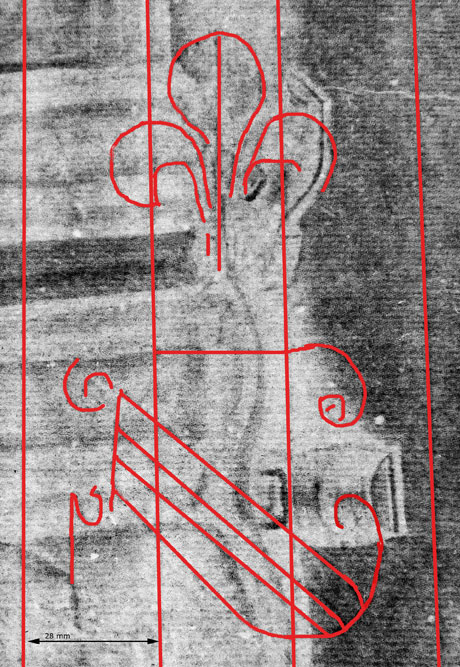
Fig 4. Diagram highlighting a Strasburg bend and lily watermark found in Brooks’ mezzotint print (chain lines 28mm apart)
Comparative research of all available impressions is necessary in order to complete this study. According to Sheila O’Connell (Prints and Drawings curator, British Museum) two impressions of this print within the BM collection also have “lily and bend” watermarks. So, despite his public claim, there is no evidence at this point that Brooks used an Irish paper source.
Eighteenth-century Irish paper-making
Samuel Madden, co-founder of the Royal Dublin Society, actively campaigned in a pamphlet entitled Reflections and Resolutions Proper for the Gentlemen of Ireland as to Their Conduct for the Service of Their Country (1738) for direct support to the Irish paper industry:
“Paper is another Manufacture that we might easily nurse up here, not only to the saving us several thousand pounds every year, which we send to Holland for it, but if our merchants wou’d [sic] heartily engage in it, we might make enough of it for the market in England.”
Thanks to Madden, Irish papermakers received financial encouragement in the form of annual awards granted for the best domestically produced paper. In 1737, for example, Thomas Slator was granted five-hundred pounds to establish a new paper-mill specialising in high quality paper “in the best Dutch manner”. By the 1740s, about nineteen paper mills existed in or around Dublin alone. The success and longevity of three family-run mills such as Slator’s (Rathfarnham), Michael McDonnell (Tallaght) and Robert Randall (Newbridge) is notable.
Despite these developments, Dutch papermakers continued to make huge quantities of paper, having mastered a faster process using the Hollander beater. For over forty years (1740-80), imported Dutch and French printing paper was sold at two shillings and four pence per ream (500 sheets) and so dominated 18th century Irish paper trade.
Brooks’s paper source?
The outcome of this investigation inspires some interesting speculation regarding Brooks’ advertisement and many unanswered questions awaiting research in the future! Why did Brooks go to the trouble of promising to use Irish paper and evidently not do so? It could be that there was simply a lack of high quality Irish paper at the time of publishing. Or, Brooks may have used Irish paper in an earlier version of the print. It is also possible that Brooks made an entirely false claim to use Irish paper; the practice of puffery was common in newspaper advertising. Moreover, the promotion of the Irish papermaking industry – especially for producing high quality white paper – may have influenced Brooks’ claim to use Irish paper. His reference to “superfine Royal Irish paper” might have been designed to attract the attention of the reader, the Dublin mezzotint-buying clientele. Brooks may therefore have been pursuing a clever marketing strategy to ensure the sale of his mezzotints.
Find out more:
Churchill, W.A. Watermarks in paper in Holland, England, France, etc., in the XVII and XVIII centuries and their interconnection. Amsterdam, 1965.
Alexander, David. “The Dublin Group: Irish Mezzotint Engravers in London, 1750-1775.” Quarterly Bulletin of the Irish Georgian Society. XVI. July-Sept. (1973): 72-93.
Phillips, James W. Printing and Bookselling in Dublin, 1670-1800: A Bibliographical Enquiry. Dublin: Irish Academic Press, 1998.
Pollard, Mary. Dublin’s Trade in Books 1550-1800. Oxford: Clarendon Press, 1989.
Institut D'histoire du Livre http://ihl.enssib.fr/en/paper-and-watermarks-as-bibliographical-evidence/bibliographical-annotations-and-orientations
Viola da Gamba Society’s interesting report of watermark in music manuscripts http://www.vdgs.org.uk/files/indexmss/08%20Watermarks.pdf
Papermaking by hand at Hayle Mill, England in 1976 https://www.youtube.com/watch?v=Xs3PfwOItto
A short film describing all the processes in making fine paper including a section devoted to making and fitting a watermark to a mould.
www.memoryofpaper.eu European integrated digital environment for paper history and expertise.
